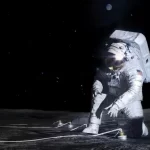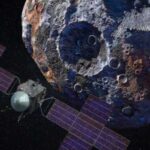Elon Musk’s Starlink Satellites Are ‘Slowly Poisoning Us All’
The post Elon Musk’s Starlink Satellites Are ‘Slowly Poisoning Us All’ appeared first on Healthy Holistic Living.
Have you ever looked up at the night sky and marveled at the stars? Now, imagine if those clear, twinkling beauties were obscured by something less awe-inspiring: a cloud of space debris. Recent studies are sounding the alarm over the rapid increase in satellite launches, particularly those by high-profile projects like Starlink, which aim to blanket our orbit with internet satellites.
But at what cost? Dr. Sierra Solter-Hunt, a former NASA physicist, brings our attention to a less-discussed but critical issue: the potential environmental fallout from these metal fragments hovering above us. Could these technological marvels be subtly shifting the balance of our planet’s protective barriers?
This article delves into the hidden consequences of our sky-high ambitions and explores how they might be influencing not just the cosmos, but our health and environment right here on Earth. Join us as we uncover what lies beyond the shimmer of these celestial sentinels.
The Satellite Surge: Starlink’s Expanding Orbit
As we push the boundaries of technology and strive for greater connectivity, the skies above us grow increasingly crowded. Elon Musk‘s Starlink project is at the forefront of this orbital expansion, with plans to deploy tens of thousands of satellites to provide global internet coverage. As of the latest count, over 5,500 Starlink satellites circle the Earth, a number that represents just the beginning of an ambitious cosmic blueprint.
The Numbers Game
The sheer volume of satellites now orbiting Earth is staggering. Current estimates suggest that there are about 10,000 satellites in space, but with companies like SpaceX leading the charge, this number could balloon to 100,000 within the next decade. This exponential increase isn’t just a testament to human ingenuity; it’s a burgeoning concern for environmental scientists and astronomers alike. Each satellite, while small in size, contributes to a vast cloud of metal that could have unforeseen effects on our planet’s atmosphere and magnetic fields.
Starlink’s mission is simple: to bring high-speed internet to every corner of the globe. However, the environmental ledger of this mission is complex. The process of maintaining and eventually decommissioning these satellites involves the shedding of materials and potential malfunctions, which can lead to debris that remains in orbit. This debris, made up of metals and other materials, does not just vanish; it accumulates, adding to a layer of space junk that encircles our planet.
Are we fully considering the long-term impacts on our planet’s atmospheric health in this rush to wire the world?
The Rising Tide of Space Debris: A Growing Concern
The exponential growth of space debris presents a formidable challenge to the sustainability of Earth’s orbital environment and the safety of space operations. As humanity ventures further into space exploration and satellite deployment, the accumulation of debris poses significant risks to both current and future space endeavors.
The sheer volume of space debris orbiting Earth is staggering, with estimates indicating tens of thousands of objects larger than a softball and millions of smaller fragments. This debris includes defunct satellites, spent rocket stages, and fragments from past collisions, all whirling around the planet at velocities exceeding thousands of kilometers per hour. The crowded orbital environment increases the likelihood of collisions, which can generate even more debris in a cascading effect known as the Kessler syndrome[1†source].
Impact on Space Operations
The proliferation of space debris poses a direct threat to operational spacecraft and satellites. Even small fragments can cause catastrophic damage upon impact, due to the immense velocities involved. Collisions with debris can disable or destroy satellites, disrupt communication and navigation systems, and jeopardize critical infrastructure such as weather forecasting, environmental monitoring, and national security satellites[2†source].
Beyond the immediate risks to operational satellites, space debris also poses challenges for future space exploration endeavors. Human spaceflight missions, in particular, face increased risks from debris impacts, which could endanger crewed spacecraft and space habitats. Furthermore, the accumulation of debris in key orbital regions, such as low Earth orbit (LEO), can hinder the deployment of new satellites and spacecraft, complicating efforts to expand humanity’s presence in space[3†source].
Environmental Impact
The proliferation of space debris also has environmental implications for Earth’s orbit and beyond. The presence of debris in orbit not only increases the risk of collisions but also contributes to the generation of orbital debris through fragmentation events. These fragments can remain in orbit for years or even decades, posing ongoing hazards to operational spacecraft and future missions. Moreover, the accumulation of debris in key orbital regions can hinder space exploration and utilization, limiting humanity’s ability to harness the potential of space for scientific research, commerce, and innovation[4†source].
Mitigation Efforts
Addressing the challenge of space debris requires a concerted effort from the international community. Efforts to mitigate space debris include measures such as debris removal technologies, spacecraft design improvements to minimize debris generation, and regulations to limit the creation of new debris. International collaboration is essential to develop and implement effective strategies for debris mitigation, ensuring the long-term sustainability of space activities and safeguarding the orbital environment for future generations[5†source].
Unseen Risks: Scientific Concerns Over Satellite Debris
The expansion of satellite networks, while a technological triumph, carries with it a set of scientific concerns that cannot be overlooked. Dr. Sierra Solter-Hunt, whose background in NASA’s space programs lends her insights significant weight, has voiced alarming predictions about the potential environmental repercussions of unchecked satellite debris.
Disruption of Earth’s Protective Shield
Central to Dr. Solter-Hunt’s concerns is the potential for satellite debris to disrupt the Earth’s magnetosphere. This invisible shield, largely taken for granted, is crucial for protecting life on our planet from deadly cosmic rays and solar radiation. According to her research, the metal particles from decaying satellites could accumulate and interfere with this vital barrier. The idea is that these particles could trap or distort the magnetic field, potentially weakening the magnetosphere and leaving us vulnerable to high-energy particles from space.
The Theory of Atmospheric Stripping
Drawing parallels to planetary bodies like Mars and Mercury, Dr. Solter-Hunt suggests that Earth could suffer a similar fate through what she terms “atmospheric stripping.” This process could occur if the conductive properties of accumulated satellite debris effectively create a barrier that hinders the atmosphere’s natural retention capabilities. Although this scenario is considered an extreme case, it underscores the potential for satellite megaconstellations to alter fundamental environmental protections in ways we are only beginning to understand.
A Layer of Conductive Metal Dust
The threat’s specifics involve forming a conductive layer of metal dust, which could settle in a concentrated region and disrupt the natural processes that shield our planet. Dr. Solter-Hunt’s study draws attention to the significant amounts of metallic debris being burnt up and released into Earth’s atmosphere every hour by satellites like those from Starlink. This relentless accumulation poses a serious question: are we engineering a problem of cosmic proportions?
Through these points, the scientific community aims to shed light on the potential risks associated with satellite mega constellations. While the debate continues, with varying opinions on the severity of these impacts, the consensus is clear—more research is imperative to understand the environmental implications of our advancements above fully.
Impact on Earth’s Magnetosphere and Atmosphere
Satellite debris poses a significant threat to Earth’s magnetosphere and atmosphere, potentially disrupting vital protective mechanisms and increasing the risk of harmful cosmic radiation exposure. Understanding the potential consequences requires a closer look at how satellite debris interacts with Earth’s magnetic field and atmospheric layers.
While Dr. Sierra Solter-Hunt’s research raises significant concerns about the impact of satellite debris on Earth’s magnetosphere, her findings have sparked a mixture of alarm and skepticism within the scientific community.
Dr. Solter-Hunt’s study suggests that the accumulation of conductive metal dust from satellites could potentially disrupt Earth’s magnetic field. This disruption could, in extreme cases, lead to a weakening of the protective geomagnetic field that shields our planet from harmful cosmic radiation. Her concerns are amplified by projections of an increased number of satellites re-entering Earth’s atmosphere, potentially adding significant amounts of metallic particles to the ionosphere, which could linger indefinitely.
However, many experts have expressed skepticism about the severity of the impact predicted by Dr. Solter-Hunt. Critics argue that the assumptions about the density and effects of the metallic dust might be overly simplistic and unlikely to produce the dramatic outcomes described. For instance, some point out that forming a continuous conductive shell capable of significantly altering the Earth’s magnetic field is highly unlikely given satellite debris’s current and projected densities.
Despite the criticisms, some scientists acknowledge the novelty of the situation and the need for further research. They agree that the potential for metallic pollution from satellites to affect our planet’s health and magnetic field is a new phenomenon that has not been thoroughly studied. This perspective underscores the importance of considering these environmental impacts as part of the broader discussion on space management and satellite deployment strategies.
The ongoing debate reflects a broader need for a more comprehensive understanding of how human activities in space affect Earth’s natural systems. As the number of satellites continues to grow, the imperative for rigorous scientific scrutiny and responsible space management becomes increasingly clear.
Simple Actions You Can Take to Help Mitigate Space Pollution
As we venture further into space, the importance of maintaining a sustainable orbital environment becomes increasingly clear. While the issue of space pollution may seem distant, there are straightforward steps that every individual can take to make a difference. Here are some practical tips for everyday actions that can help raise awareness and promote sustainability in space activities:
Read and Share: Stay informed about space missions and their environmental impacts by reading updates and sharing them on social media to raise awareness among your network.
Consumer Choices: When choosing services like satellite TV, internet, or GPS, opt for companies that demonstrate a commitment to sustainable space practices.
Voice Your Concerns: Participate in public consultations or forums on space projects to influence policy and decision-making through your input.
Engage with STEM: Support educational initiatives by encouraging schools to integrate space sustainability topics into their STEM curriculum.
Join Local Groups: Become active in local environmental or astronomical societies that discuss or organize events about space pollution.
Recycle and Reuse: Embrace recycling and reusing materials in your daily life to cultivate a culture of sustainability that reflects our responsibility towards space.
These actions, while small, can collectively lead to significant changes and ensure that space remains a safe and sustainable environment for future generations.
Charting a Sustainable Path in Space Exploration
The exploration of space stands as one of humanity’s most awe-inspiring achievements, pushing the boundaries of science, technology, and our understanding of the universe. However, as we reach further into the cosmos, the need to balance our ambitions with the stewardship of both our planetary and extraterrestrial environments becomes increasingly critical. The concerns raised by Dr. Sierra Solter-Hunt and others in the scientific community highlight a pressing issue: the potential environmental impacts of satellite debris.
While the visions of satellite mega-constellations promise global connectivity and technological advancements, they also pose significant challenges to the sustainability of our planet’s protective barriers. As we continue to benefit from these technologies, we must also take responsibility for their impacts. This includes supporting regulations that ensure sustainable practices, fostering innovations in debris mitigation, and advocating for corporate and governmental transparency.
By embracing these actions, we safeguard our environmental heritage and ensure that space remains a realm of wonder and exploration for future generations. Let us move forward with a commitment to sustainability that matches our drive for exploration, ensuring that our skies remain a source of inspiration, not a repository for debris.
The post Elon Musk’s Starlink Satellites Are ‘Slowly Poisoning Us All’ appeared first on Healthy Holistic Living.












